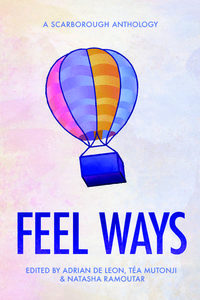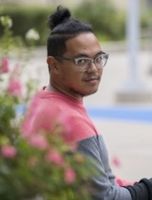"We Always Knew Our Talents... We Just Needed a Space" Adrian De Leon on Celebrating Scarborough Writers in a Stunning New Anthology
What do the writers Shyam Selvadurai, David Chariandy, Carrianne Leung, and Catherine Hernandez have in common? They've all written beloved books set in Scarborough. And they're far from the only literary lights repping the eastern Toronto suburb. Seeing the breadth of talent in the area, authors Adrian De Leon, Téa Mutonji, and Natasha Ramoutar, themselves all natives of Scarborough and acclaimed writers, set out to assemble an anthology of multi-genre Scarborough stories.
The result is the stunning Feel Ways: A Scarborough Anthology (Mawenzi House), which Canisia Lubrin praised as "a mixtape of Scarborough stories" packed with the up-and-coming writers' "fierce visions" in fiction, nonfiction, and poetry. Eternity Martis welcomed the collection as "love letters to Scarborough and to all of us who live here," offering authentic moments that range from "the heartbreak of love to buying mangos out of white vans on the weekends".
We're excited to welcome Adrian De Leon to Open Book today to speak about the anthology on behalf of the editors. He tells us about how they worked to give space for the anthology's pieces resist the white supremacist narratives often thrust onto Scarborough, about the joy of not only elevating local voices they loved but also discovering new talents, and about thinking of future readers discovering a 2021 version of Scarborough in these pages.
Open Book:
How do you view the pieces in the book as speaking to each other?
Adrian De Leon:
At times, they are in conversation; in other cases, they are in cacophony. It’s a little idealistic to try to craft something in complete harmony, as if anthologizing is composing a Baroque symphony. But we also sought the dissonance, the clash, the myriad tones that make a community what it is: complex and deeply human. For a community like Scarborough, it is important that the full range of textures and voices is captured on the page, as opposed to the one-dimensional narratives that Toronto and Canada, and particularly their White supremacist narratives, force upon this place.
OB:
What do you hope readers will take away from these pieces, after having read them all? Is there a question you set out to address or delve into through these works?
ADL:
We hope that readers in Scarborough and allied communities find themselves in these pages, and are inspired to build momentum for creative initiatives in our neighbourhoods. We also hope that readers outside of the community will find something familiar about our relationships with the city, as they reflect on their own hometowns.
OB:
Are there any writers you discovered through this project? What, if anything, surprised you about the writers whose work you came to through this book?
ADL:
Here’s the thing about anthologizing a community like Scarborough. We always knew our talents, and we just needed a space to showcase it. Many of the writers we had known or had followed their work before FEEL WAYS. But we became introduced to many others who we had not read before, and who were brand new to even attempting to publish their work. The most surprising things were the range of technique and theme, and the willingness to experiment and throw themselves into the editorial process.
OB:
How do you view the role of an editor in relation to an anthology?
Your CanLit News
Subscribe to Open Book’s newsletter to get local book events, literary content, writing tips, and more in your inbox
ADL:
The anthology is a space of community; the editor is its custodian. For our contributors, it was important that their unique perspectives and approaches to the literary craft were given the platform they deserve, but also invite connections with other writers in the collection. And because it is a book, to be printed and read (hopefully) years later, it falls on the editor to think about how future readers, too, might see this as a manifestation of a community in 2021, and an inspiration for their own community-building.
OB:
What are you working on next?
ADL:
Téa is working on her debut novel. She is also moving stateside to attend New York University’s MFA program in Creative Writing in the Fall, with a focus on fiction.
Natasha just came out with her debut poetry collection, Bittersweet, also with Mawenzi House. She is currently touring it virtually in readings and events all over Canada.
Adrian just finished his second poetry collection, barangay: an offshore poem, which is forthcoming in Fall 2021 with Buckrider Books/Wolsak & Wynn. He is also working on a new TV show for PBS called A People’s History of Asian America, debuting in May 2021.
___________________________________________
Adrian De Leon is a writer and educator from Manila by way of Scarborough. He is the author of two poetry collections: Rouge (Mawenzi House, 2018), and barangay: an offshore poem (Buckrider Books/Wolsak & Wynn, 2021). He lives in Los Angeles, where he is an ethnic studies professor at the University of Southern California.
Born in Congo-Kinshasa, Téa Mutonji’s work focuses primarily on friendship, womanhood, race and sexuality. Her debut collection of short stories, Shut Up You’re Pretty was shortlisted for the Atwood Gibson Writers’ Trust Fiction Prize (2019) and won the Edmund White Debut Fiction Award (2020) and the Trillium Book Award (2020).
Natasha Ramoutar is an Indo-Guyanese writer by way of Scarborough (Ganatsekwyagon) at the east side of Toronto. She is the Social Media Assistant at the Festival of Literary Diversity. Her poetry collection, Bittersweet, was published by Mawenzi House in 2020. She is the fiction editor of Feel Ways, an anthology of Scarborough writing, published in 2021. She lives in Scarborough, Ontario.






